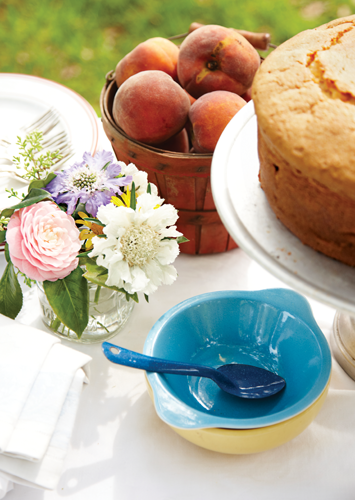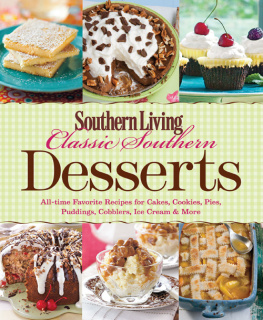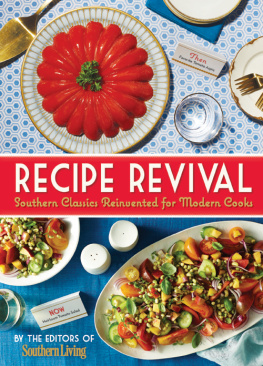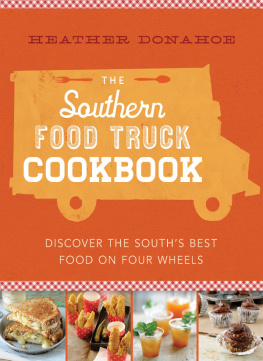 The Southern Living Community Cookbook CELEBRATING FOOD & FELLOWSHIP IN THE AMERICAN SOUTH Sheri Castle
The Southern Living Community Cookbook CELEBRATING FOOD & FELLOWSHIP IN THE AMERICAN SOUTH Sheri Castle 


 A collection of recipes is an inspired way for a community to get together, in a manner thatunlike sports contests, musical performances, or religious convocationdoesnt involve dressing up or arriving on time. We can commune with each other at ease, in that most exciting arena of private life, the kitchen. Though the gathering may be virtual, the discourse that goes on within the pages of a community cookbook says much about who we are (indelibly, we might add) and offers some delicious opportunities for storytelling and public embarrassment. Sheri Castle, a master of the art of the printed recipe, also has an ear for a great story. When she began this project, she resolved to read every single recipe published in Southern Living magazine from February 1966 to February 2014, more than 45,000 in all. This heroic feat, never before attempted, pays off in the rare perspective this collection offers on the food and personality of the South today.
A collection of recipes is an inspired way for a community to get together, in a manner thatunlike sports contests, musical performances, or religious convocationdoesnt involve dressing up or arriving on time. We can commune with each other at ease, in that most exciting arena of private life, the kitchen. Though the gathering may be virtual, the discourse that goes on within the pages of a community cookbook says much about who we are (indelibly, we might add) and offers some delicious opportunities for storytelling and public embarrassment. Sheri Castle, a master of the art of the printed recipe, also has an ear for a great story. When she began this project, she resolved to read every single recipe published in Southern Living magazine from February 1966 to February 2014, more than 45,000 in all. This heroic feat, never before attempted, pays off in the rare perspective this collection offers on the food and personality of the South today.
We have spent our careers avoiding the bundling term the South, feeling that it didnt do justice to the regional diversity or the modernity we experience as we travel from Pikeville, Kentucky, to Pensacola, Florida; this cookbook promises to redeem the singular South when it comes to food, to bind together in one volume an impression of how distinctive our culinary values may, in fact, be. Reading through the more than 200 recipes in The Southern Living Community Cookbook, you will discern them yourself: an inventive streak, a groove on the sweet/tart/hot nexus, a knowing sense of humor. And perhaps a note of gloatingthose of us who live in the South are fortunate, through no fault of our own, simply by our given position on the globe, to have an abundance of yummy raw materials available to us, making our food lives incredibly rich. Yours can be too, no matter where you live, if you dig into these Southern recipes. Matt Lee and Ted Lee Charleston, South Carolina Community Cookbook: Recipes Good Causes and Memories 
 Good Food, Good Read
Good Food, Good Read  A community cookbook is a collection of recipes submitted by members of a local group, intended to be sold as a fund-raiser or as memorabilia. While that is true, it says little about its long-lasting allure.
A community cookbook is a collection of recipes submitted by members of a local group, intended to be sold as a fund-raiser or as memorabilia. While that is true, it says little about its long-lasting allure.
Community cookbooks are, of course, cookbooks. But they are also histories, storybooks, souvenirs, and heirlooms. When it comes to their devotees, you have us at spiral bound. Recipes A great vintage community cookbook, especially one created in the South, holds good food and a good read, the equivalent of a brimming recipe box plus the scribbled notes and whispered secrets that cover the tips, advice, and stories that a generous cook shares with family members, friends, and neighbors. Although some community cookbooks are highly polished productions, most are humble, homey paperbacks full of cherished recipes from home kitchens. Community cookbooks are scrapbooks of vernacular cooking.
They give us a peek into the way people lived, cooked, and ate in a specific place at a specific time. Finding an old community cookbook is like opening a time capsule. Although there is likely a community cookbook somewhere that touches on nearly every subject and locale, no one book set out to be an exhaustive encyclopedic tome. Cookbook committees aimed to sell a collection of local recipes in the service of a good cause. Its as though the cookbook committee, which was often a one-woman force of nature, asked their cohorts to prepare their signature recipes for a potluck dinner fund-raiser. A great community cookbook not only shows who brought what, it gives us a copy of all the recipes to boot.
Good Causes Community cookbooks might be written for a bit of posterity, but most are written to sell, and sell big. These books are fund-raisers. Historians tell us that Maria J. Moss wrote the first community cookbook in 1864. A Poetical Cook-Book was a small, simple volume that she sold in Philadelphia to raise money for Civil War field hospitals. In a time when nearly all women were financially and politically dependent on men, producing and selling a cookbook was a rare opportunity to make money and direct its use.
Determined women could band together to produce a cookbook without overstepping their social bounds. It was a benign yet effective way to give themselves a voice on local issues and to fund their chosen causes. In turn, purchasing a cookbook was an innocuous way for a housewife to donate money. By 1920, as many as 6,000 community cookbooks had been published in the United States. Working primarily through churches, the most powerful avenue of the time, women were raising money to fund civic causes even though they were not yet allowed to vote. It was also a way to be acknowledged.
Having a recipe in a community cookbook was the only place that many women would ever see their names in print, even though they were usually only the Mrs. that preceded their husbands name, a practice that persisted in some communities until the 1970s. Community cookbooks remain powerful fund-raisers. A volume can stay in demand for decades. For example, River Road Recipes from the Junior League of Baton Rouge has sold over 1.3 million copies, resulting in donations in excess of $3 million to local causes. Not all books have sold that well, of course, but if we imagine their cumulative effect over the years, their benefit is formidable.
That being said, it would be unfair to exclude the community cookbooks that were written solely as love letters, gifts, and mementos. A reunion cookbook that gathers and memorializes a familys recipes is invaluable. A collection of recipes from the annual dinner on the grounds at a local church is surely some of the best food ever committed to paper. A construction paper cookbook compiled by a group of kindergarteners is priceless. Those cookbooks go right to the heart of the matter. Considered individually, a community cookbook is a snapshot of local appetites and proclivities.
Considered collectively, these books serve as a documentary of American foodways. They reveal how our regional cooking evolves and changes, swiftly and profoundly at times. We can see one eras bedrock ingredients, techniques, and dishes nearly disappear, to be replaced by more modern and convenient ways. We see the introduction of new foods, sometimes displacing or diluting local traditions. We see ingredients that were once exotic become ordinary. We see the effect of new appliances and technologies.
We see classics endure and silly trends come and go. We see cooks respond to times of privation and we see them celebrate abundance. As both personal and social histories, community cookbooks are mirrors and projectors, diaries and exhibitions. A defining characteristic of a community cookbook is that they say much more about the contributors and their circumstances than about any intended audience. These books are, at their core, a form of folklore. Memoirs 
Next page










 The Southern Living Community Cookbook CELEBRATING FOOD & FELLOWSHIP IN THE AMERICAN SOUTH Sheri Castle
The Southern Living Community Cookbook CELEBRATING FOOD & FELLOWSHIP IN THE AMERICAN SOUTH Sheri Castle 


 A collection of recipes is an inspired way for a community to get together, in a manner thatunlike sports contests, musical performances, or religious convocationdoesnt involve dressing up or arriving on time. We can commune with each other at ease, in that most exciting arena of private life, the kitchen. Though the gathering may be virtual, the discourse that goes on within the pages of a community cookbook says much about who we are (indelibly, we might add) and offers some delicious opportunities for storytelling and public embarrassment. Sheri Castle, a master of the art of the printed recipe, also has an ear for a great story. When she began this project, she resolved to read every single recipe published in Southern Living magazine from February 1966 to February 2014, more than 45,000 in all. This heroic feat, never before attempted, pays off in the rare perspective this collection offers on the food and personality of the South today.
A collection of recipes is an inspired way for a community to get together, in a manner thatunlike sports contests, musical performances, or religious convocationdoesnt involve dressing up or arriving on time. We can commune with each other at ease, in that most exciting arena of private life, the kitchen. Though the gathering may be virtual, the discourse that goes on within the pages of a community cookbook says much about who we are (indelibly, we might add) and offers some delicious opportunities for storytelling and public embarrassment. Sheri Castle, a master of the art of the printed recipe, also has an ear for a great story. When she began this project, she resolved to read every single recipe published in Southern Living magazine from February 1966 to February 2014, more than 45,000 in all. This heroic feat, never before attempted, pays off in the rare perspective this collection offers on the food and personality of the South today.
 Good Food, Good Read
Good Food, Good Read  A community cookbook is a collection of recipes submitted by members of a local group, intended to be sold as a fund-raiser or as memorabilia. While that is true, it says little about its long-lasting allure.
A community cookbook is a collection of recipes submitted by members of a local group, intended to be sold as a fund-raiser or as memorabilia. While that is true, it says little about its long-lasting allure.